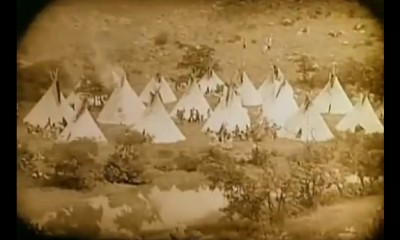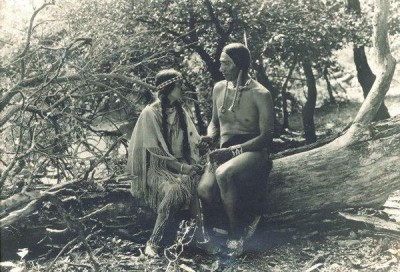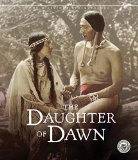| Reviews & Columns |
|
Reviews DVD TV on DVD Blu-ray 4K UHD International DVDs In Theaters Reviews by Studio Video Games Features Collector Series DVDs Easter Egg Database Interviews DVD Talk Radio Feature Articles Columns Anime Talk DVD Savant Horror DVDs The M.O.D. Squad Art House HD Talk Silent DVD
|
DVD Talk Forum |
|
|
| Resources |
|
DVD Price Search Customer Service #'s RCE Info Links |
|
Columns
|
|
|
Daughter Of Dawn, The
Milestone Films' great Daughter of Dawn Blu-ray release should be of interest to those who read American history, watch silent cinema, or are interested in the possibilities of the Western genre. Norbert Myle's obscure silent Western from 1920 recounts a love triangle between Indigenous people from the Kiowa and Comanche tribes of the Southern Plains and is most notable for being the only film with an all Native American cast and for being the only silent Western in which the Native American characters are played by real Native people. Milestone has transferred the meticulously restored Oklahoma Historical Society print to Blu-ray in an edition of the film that underlines its romantic epic aspirations and its unique mode of representation.

Teepees, weapons, horses, clothes and many everyday items that were part of the actors' everyday lives were provided to the production as props. The Academy-sized aspect ratio captures the vastness of the Wichita Mountains of Southern Oklahoma, where the Kiowa and Comanche actors lived. The inclusion of many of the items and customs that were part of the real-life fabric of the Indians' lives is rare for a Western of any era and gives Daughter of Dawn a veneer of authenticity that also underlines the peculiar historical fact that the actors were only several generations removed from ancestors who knew the Western landscape before European settlement. With no white actors in the film and a story that was informed by Plains Indian culture, the all-Indigenous actors of Daughter of Dawn were able to tell a story on their own terms in a manner that even many modern Native American/Indigenous films fail to reach as they strain for a kind of authenticity that is unattainable in all artistic forms.
In The Daughter of Dawn, melodrama unfolds in the world of the Kiowa as they roam the open plains in search of buffalo. A grand wide shot in the opening of the film shows a herd of buffalo, one of the last of its kind, stamping across the Oklahoma landscape. A love triangle develops when Red Wing (Wanada Parker) is rebuffed by Black Wolf (Jack Sankey-Doty), who is in love with the Daughter of Dawn (Esther Labarre), so named because she was born when the sun rose. Dawn rejects Black Wolf because she is in love with White Eagle (White Parker, the real-life son of Comanche chief Quanah Parker, who lived through his tribe's transition from independence to being overseen by the Federal government), which drives Black Wolf into a jealous rage.
After a raid on the Kiowa by a band of Comanche who steal their horses, Black Wolf asks for Dawn's hand in marriage. He seeks vengeance when she rejects him and he realizes that the Daughter of Dawn is in love with White Eagle. When White Eagle tells the chief that he plans to marry Dawn, the chief devises a challenge that White Eagle and Black Wold must endure: both men must jump off of a cliff. Whoever survives gets to marry the Daughter of Dawn.

Like many silent films, The Daughter of Dawn's damaged nitrate reels languished in obscurity before they were rediscovered and restored. All five reels of the 80-minute movie were heavily damaged and sat undiscovered until 2008, when a private investigator who received the film as payment for a case sold it to the Oklahoma Historical Society for five-thousand dollars. A restoration process began that same year and a musical score for the film was written by composer David Yeagley from the University of Oklahoma, which adds a layer of grandeur to the romantically naturalistic images.

However, The Daughter of Dawn comes dangerously close to falling into stereotype through its use of a romantic tone when portraying Indian characters who live closely to the natural world. If the film serves as a time capsule for its creators' decision to use items actually owned by the Kiowa and Comanche tribes at the time of its filming, then the somewhat simplistic portrayal of both groups shows that the film medium can only go so far in showing any group of people in a realistic light. Like most good movies, The Daughter of Dawn uses realism as a basis for the heightened sense of reality that all films reach to bring its viewers to a different time and place.
The Blu-ray
Video: The only known print of Daughter of Dawn, made of highly flammable nitrate, sat undiscovered for decades before it was restored by the Oklahoma Historical Society, with the help of the National Film Registry, which provided funding for its restoration. The restoration has brought out all of the original color tints to life and gives the finished look of the film a vibrancy that looks sharp on Blu-ray.
Milestone's Daughter of Dawn release preserves its original 4:3 aspect ratio. A full frame shows that widescreen isn't always necessary to convey large battle scenes or the awesome scope of seemingly endless landscapes. It is to the credit of the original crew and the restoration team that a deep depth of field is preserved and conveys the epic feel and simultaneous sense of authenticity that the filmmakers intended, best conveyed in a perspective shot of a line of teepees that shows the wide depth of the film's images, along with ceremonial scenes that are observational and borderline ethnographic.
Newly created English intertitles blend seamlessly with the original film.
Audio: David Yeagley's score, finished in 2012, is the only element on the disc's stereo surround track. The new score, inspired by the film's original music, blends perfectly with Daughter of Dawn.
Extra Features: There are no extra features.
Final Thoughts:
The Daughter of Dawn is unique for being the only Western to feature an all-Native-American cast that was no more than several generations removed from relatives who had never seen European settlers. The film is a mini-epic of spurred love and epic battles that are absent of the White VS Indian conflict that mires most Indians in ugly racial stereotypes within the Western genre. While the realistic props and rituals are based on the real cultures of the Kiowa and Comanche tribes, the film proves that representation in film can only go so far, and that all films must only use realism as a basis for the heightened sense of reality that all movies must strive for in order to achieve artistic success.
|
| Popular Reviews |
| Sponsored Links |
|
|
| Sponsored Links |
|
|
| Release List | Reviews | Shop | Newsletter | Forum | DVD Giveaways | Blu-Ray | Advertise |
|
Copyright 2024 DVDTalk.com All Rights Reserved. Legal Info, Privacy Policy, Terms of Use,
Manage Preferences,
Your Privacy Choices | |||||||












